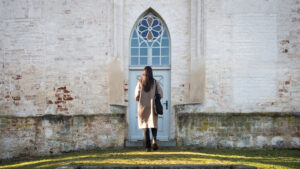On Easter weekend I asked church leaders to consider some of the relevant medical, political, and psychological elements that will factor into the decision about when our church buildings will reopen. As we eagerly look forward to that day, many of us who serve as pastors are beginning to grapple with what comes next. Despite what some people in our congregations may assume, the loosening of restrictions on gatherings will not mean the COVID-19 crisis has ended. What it will do is shift the burden of risk onto the shoulders of pastors and elders.
One of the most important considerations for our churches when we are allowed to gather together again is the likelihood we will expose our congregations to the virus. What is the risk of exposure to our people? How can we know?
Fortunately, the risk assessment is fairly straightforward, and calculating the probability of exposure requires only three numbers: population size (p), group size (g), and number of carriers (c). What complicates the calculation is that we may be certain of only one out of those three factors in the equation. All churches can reliably estimate the maximum size of their congregation, based on building size and previous attendance. But what is the relevant population size? Should you use the population of your neighborhood, city, or region? And because of lack of testing for the coronavirus, we can only make a rough guess as to the number of people who carry the virus.
Examples of Calculating Exposure Risk
Because we lack specific numbers, we have to rely on reasonable estimations. Here’s an example using two different scenarios: a large urban church in Northern Virginia and a small rural church in East Texas. For the numbers we’ll use:
p = 3.2 million (the population of the three main counties in Northern Virginia); 12,175 (the population of Red River County in Texas).
g = a 2,000-person church in Virginia; a 200-person church in Texas.
c = Various estimations (Since the current number of carriers of COVID-19 in each of these areas is unknown, I will use various estimates to determine probabilities of exposure.)
The charts below show how many people in each of those areas would need to be carrying the virus for there to be a specific chance of exposure at each particular church. For example, if there are 170 carriers of the novel coronavirus in Northern Virginia, there is a 10 percent chance someone at the church would be exposed. Similarly, if there are 18 contagious people in Red River County there is a 25 percent chance at least one carrier of the virus would attend the church.
For the church in Northern Virginia the calculations are:
Percent change of exposure (number of carriers):
10 percent (170), 25 percent (450), 50 percent (1,100), 75 percent (2,200), 100 percent (7,700)
For the church in Texas the calculations are:
Percent change of exposure (number of carriers):
10 percent (7), 25 percent (18), 50 percent (42), 75 percent (84), 100 percent (280)
In urban Virginia, 0.2 percent of the relevant population would need to be contagious before there would be 100 percent chance someone infected attended the church. In rural Texas, though, to reach 100 percent probability, 2.2 percent of the county would have to be infected.
(TGC’s Phil Thompson created a form that allows you to answer three questions to run the calculation. You can also run your own calculations at Wolfram Alpha following this format: p=3200000, c=170, g=2000, 1-1(1-c/p)^g //N where p is the population size, c is the number of carriers, g is the group size, and the “//N” at the end isn’t a division but a command to Wolfram Alpha to give you a numerical answer. Thanks to Alex Tabarrok for the formula.)
Smaller Isn’t Necessarily Safer
The Texas church might decide to reduce their risk of exposure by dividing the congregation into smaller groups. They assume there is at least 280 infected people in the county and so meeting together the probability of exposure would be 100 percent. Instead of 200 people meeting at the church building, they decide to have 10 groups of 20 people meet in individual homes.
What would be the new probability of exposure be for the congregation? We might assume the risk is 10 percent per group, since the previous 100 percent risk is divided equally among 10 groups. But the actual risk of exposure per group of 20 people is not 10 percent but 37 percent.
Breaking large groups into smaller groups may lower an individual’s risk of exposure. But all other things being equal, it doesn’t change the probability that someone in the church will be exposed. If the probability an infected person will be in a 200-member congregation is 100 percent, dividing those same 200 people into 10 groups of 20 does not change the probability—there is still a 100 percent chance one of those people is infected.
Why then does the government say to avoid gatherings of more than 10 people? Where did the groups size of 10 come from? The number appears to have been chosen rather arbitrarily. There is also no standard or scientific definition of what a “mass gathering” of people is, says Michael Osterholm, director of the Center for Infectious Disease Research and Policy at the University of Minnesota. And as we see in the examples above, what matters more than group size is the prevalence of the virus within a particular population. “If 20 percent of the population is infected,” Osterholm told The New York Times, “you can have one meeting with 10 people in it and pretty well assume that there will be someone there who can transmit the virus.”
(Despite not being a cure-all, there may still be prudent reasons for our congregations to meet in smaller groups. For instance, elderly members who self-quarantine for most of the week could meet together and avoid coming into contact with younger people who may be either asymptomatic or transmitting the virus through outside contact. Reducing the number of people meeting at one time may also allow for more social distancing measures (e.g., additional space between seats) that might have a marginal effect on reducing transmission.)
Do the Math, But Trust the Lord
The realization that someone in our church is likely to be exposed when we meet again is a daunting reality. But we should not be afraid to face the truth, and performing such risk assessment calculations for your church should not lead to paralysis. We can’t know for sure how accurate our assessments will be, but we should do the best we can with the most reliable information we have available. Most importantly, we should be clear and honest about what we believe to be the particular risk for our church body so we can allow members to decide what precautions they want to take with their safety.
You can take comfort in knowing you are not the only church leader having to make hard decisions. Almost every church in America will return to their buildings and open their doors before the danger of COVID-19 has passed. We will all be doing the best we can under impossible circumstances.
We are in this together, and we are not alone: Jesus promises to be with us always, to the end of the age (Matt. 28:20). It’s his church; we are merely caretakers. Take care in applying prudence and wisdom to your decision-making. Do the math and do what you can to faithfully protect your flock. But know that ultimately, the Good Shepard will always watch over his sheep, no matter where they might be gathered.
Try Before You Buy: FREE Sample of TGC’s New Advent Devotional
 Choosing the right Advent daily devotional can be tough when there are so many options. We want to make it easier for you by giving you a FREE sample of TGC’s brand-new Advent devotional today.
Choosing the right Advent daily devotional can be tough when there are so many options. We want to make it easier for you by giving you a FREE sample of TGC’s brand-new Advent devotional today.
Unto Us is designed to help you ponder the many meanings of this season. Written by TGC staff, it offers daily Scripture readings, reflections, and questions to ponder. We’ll send you a free sample of the first five days so you can try it out before purchasing it for yourself or your church.

































